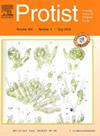The protist symbionts of Reticulitermes tibialis: Unexpected diversity enables a new taxonomic framework
IF 2.1
3区 生物学
Q4 MICROBIOLOGY
引用次数: 0
Abstract
Wood-feeding termites harbor specialized protists in their hindguts in a classic nutritional mutualism. The protists are vertically inherited, which has generated a broad-scale pattern of codiversification over ∼150 million years, but there are many incongruences due to lineage-specific loss and transfer of symbionts. Despite the evolutionary and economic importance of this symbiosis, the symbiont communities of most termite species are incompletely characterized or entirely unstudied. Here, we have investigated the protist symbiont community of Reticulitermes tibialis, using single-cell PCR to link morphology to 18S rRNA gene sequences. The protists belong to at least 41 species in 3 major lineages within Metamonada: Spirotrichonymphida, Pyrsonymphidae, and Trichonympha. The Spirotrichonymphida symbionts belong to 6 genera, including Pseudospironympha, which has not been found in Reticulitermes until now, and Dexiohelix, a new genus. Pyrsonymphidae traditionally include just Pyrsonympha and Dinenympha, but our morphology-linked 18S phylogeny indicates that both genera are polyphyletic. We accordingly restrict the definitions of Pyrsonympha and Dinenympha to the clades that include their type species, and we propose 5 new genera to accommodate the remaining clades. Short-read 18S amplicon sequencing revealed considerable variation in community composition across R. tibialis colonies in Arizona, suggestive of a symbiont metacommunity. Symbiont species varied in their prevalence across colonies, with a core set of about 12 highly prevalent symbiont species, 11 species with intermediate prevalence, and 18 rare species. This pattern contrasts with the traditional paradigm of consistent symbiont community composition across colonies of a termite species.
tibialis的原生共生体:意想不到的多样性提供了一个新的分类框架
以木材为食的白蚁将专门的原生生物藏在它们的后肠中,这是一种典型的营养互助关系。原生生物是垂直遗传的,这在大约1.5亿年的时间里产生了广泛的共多样化模式,但由于谱系特异性的损失和共生体的转移,存在许多不一致。尽管这种共生关系在进化和经济上具有重要意义,但大多数白蚁物种的共生群落尚未完全表征或完全未被研究。本研究利用单细胞PCR技术,对tibialis Reticulitermes tibialis原生共生体群落进行了形态学与18S rRNA基因序列的关联研究。这些原生生物至少有41种,分属孢子虫纲的3个主要分支:螺旋体滴虫科、棘滴虫科和毛滴虫科。螺旋体属共属6属,其中拟螺旋体属(Pseudospironympha)为目前尚未在reticuliterae中发现的属,Dexiohelix属为新发现属。Pyrsonymphidae传统上只包括Pyrsonympha和Dinenympha,但我们的形态关联的18S系统发育表明这两个属都是多系的。因此,我们将Pyrsonympha和Dinenympha的定义限制在包含其模式种的分支上,并提出了5个新属来容纳剩余的分支。短读18S扩增子测序结果显示,亚利桑那州胫骨鼠群落组成存在较大差异,提示存在共生元群落。共生体物种在各菌落间的流行度存在差异,其中高流行种约12种,中等流行种11种,稀有种18种。这种模式与传统的白蚁群落组成模式形成鲜明对比。
本文章由计算机程序翻译,如有差异,请以英文原文为准。
求助全文
约1分钟内获得全文
求助全文
来源期刊

Protist
生物-微生物学
CiteScore
3.60
自引率
4.00%
发文量
43
审稿时长
18.7 weeks
期刊介绍:
Protist is the international forum for reporting substantial and novel findings in any area of research on protists. The criteria for acceptance of manuscripts are scientific excellence, significance, and interest for a broad readership. Suitable subject areas include: molecular, cell and developmental biology, biochemistry, systematics and phylogeny, and ecology of protists. Both autotrophic and heterotrophic protists as well as parasites are covered. The journal publishes original papers, short historical perspectives and includes a news and views section.
 求助内容:
求助内容: 应助结果提醒方式:
应助结果提醒方式:


